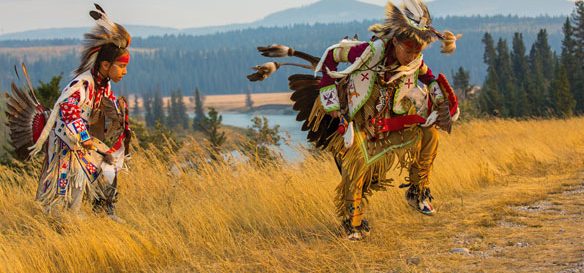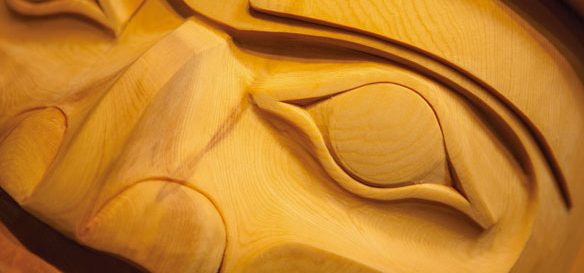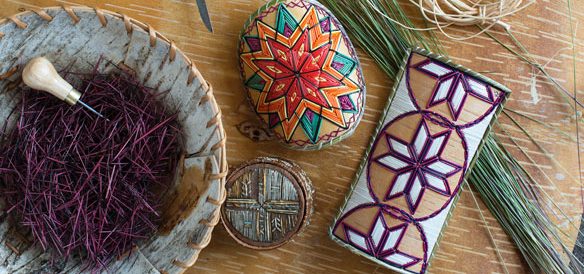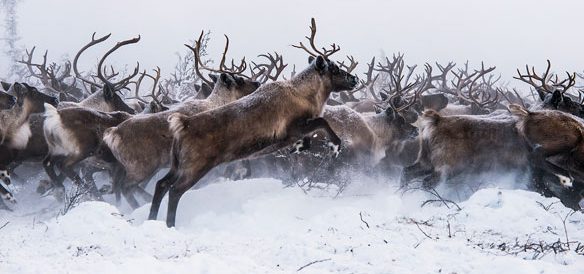
We will come out taller from this
A conversation with Keith Henry, President and CEO of the Indigenous Tourism Association of Canada (ITAC)

BOB MOWAT
While COVID-19 has battered all sectors of the global travel and tourism industry, recent research by the Conference Board of Canada and the Indigenous Tourism Association of Canada (ITAC) tells a stark tale of the impact of the coronavirus on this country’s Indigenous tourism businesses. ITAC’s boss, Keith Henry tells the story.
Maybe you could start by talking about the role of the Indigenous Tourism Association of Canada (ITAC) – its purpose; its goals; how it has evolved as an association; how it works with its members; what kind of resources it offers its members … tell us your story …
The Indigenous Tourism Association of Canada (ITAC) is the lead organization tasked with growing the Indigenous tourism industry across the country. Inspired by a vision for a thriving Indigenous tourism economy sharing authentic, memorable and enriching experiences, ITAC develops relationships with other groups and regions with similar mandates.
By uniting the Indigenous tourism industry in Canada, ITAC works to enable collective support, product development, promotion and marketing of authentic Indigenous cultural tourism businesses in a respectful protocol. Prior to 2020, Indigenous tourism was outpacing Canadian tourism activity overall, and international demand for Indigenous experiences was at an all-time high.
Currently, while the Indigenous Tourism Association of Canada has 863 members, it acts on behalf of the best interest of the industry as (whole 1,700 SMEs) with the aim of sharing rich, transformative travel experiences that showcase a modern, authentic culture. In order to do so, and help the industry rebuild post-COVID-19, ITAC recently launched the Destination Indigenous marketing campaign in an effort to encourage, highlight and educate travellers about the many Indigenous experiences that will welcome Canadians
this summer.
How has COVID-19 impacted ITAC and its members? Does ITAC have a strategy in place to help its members get through these difficult times? Can you talk about that strategy – what it involves and what the path to recovery will be?
Conference Board of Canada research conducted in partnership with the Indigenous Tourism Association of Canada (ITAC), shows that, compared to 2019, Canada’s Indigenous tourism sector will experience a 65.9% decline in direct GDP (down to $555 million) and a 59.4% decline in employment (down to 14,624 jobs) in 2020, due to COVID-19 and the global tourism industry grinding to a halt.
These findings reflect the perspectives and business realities of Indigenous tourism operators who participated in a recent wide-scale survey of the sector.
This is in stark contrast to 2019 when over 36,000 people worked in the Indigenous tourism sector, and its direct economic contribution exceeded $1.6 billion in GDP. The Conference Board of Canada research estimates that around 714 Indigenous businesses could be at risk of closure in 2020-2021.
Due to COVID-19, ITAC recently released a report on the financial challenges facing Indigenous tourism operators and recommended stimulus solutions. As well, a 2020-2021 revised action plan focused on sustaining Indigenous tourism in the face of COVID-19 was released in March, which is now complemented by the 2020-2024 Recovery Strategy.
Has ITAC and its members been able to take advantage of any of the government programs available for tourism? Have they helped? Is more needed? And, if so, what kind of further help and support is ITAC recommending?
The Federal Government Canada has promised that they will spend a further $133 million on helping Indigenous businesses suffering the economic effects of the COVID-19 pandemic, of which $16 million is being allocated in support of Indigenous businesses in the tourism sector. Additionally, ITAC has been allocated $1.95 million for its sales and marketing recovery budget, thanks to an enduring partnership with Destination Canada.
We are also pleased that the federal government committed $306.8 million dollars in stimulus funding to support the 6,000 small-medium Indigenous businesses across the country flowing through 59 different Aboriginal financial institutions in Canada.
While it is a substantial sum, more is needed. We had originally asked for $550M in loans as a solution because $40k checks aren’t enough to save our businesses. We believe that larger loans such as an “Indigenous” version of the Business Credit Availability Program (BCAP), which is being administered by Export Development Canada (EDC) and the Business Development Bank of Canada are needed. This allows larger loans for up to $6.25 million, which many of our larger members require.
The other issue that Indigenous communities face is that dealing with the traditional banking institutions, the EDC and the BDC is that many of our businesses are less than 5 years old and don’t have relationships with banks, even those with the National Aboriginal Capital Corporations Association network, so getting loans has been difficult with many of our members still working to get what they need.
That is why we argue that this is not the time for loans but rather a time for creative grants and longer financial term investments in the industry in order to provide liquidity and ensure Indigenous tourism can be rebuilt post-COVID-19.
ITAC created the COVID-19 Development Stimulus Fund in March and has redirected funding to provide non-repayable grants of up to $25,000 to help Indigenous entrepreneurs and their businesses stay afloat during these difficult times. We have already awarded 96 grants and now with the $16 million received we hope to now be able to approve the rest of the businesses who applied (we received more than 600 applications).

ITAC launched Destination Indigenous on June 21, National Indigenous People’s Day, can you talk about that? What’s this program all about? How significant is this initiative for ITAC and for Indigenous Tourism – does it take things to a new level?
ITAC launched the new Destination Indigenous marketing campaign in an effort to encourage, highlight and educate travellers about the many Indigenous experiences that will welcome Canadians this summer.
The marketing campaign includes the release of an experience Web booking platform that will link travellers with export-ready Indigenous tourism businesses who will be accepting visitors this summer; a series of Zoom backgrounds showcasing Indigenous-experience imagery from each province and territory; and a video campaign called Virtually Yours to entice tourists.
As a global leader in advancing Indigenous tourism, our goal is to help create, support and market Canada’s Indigenous cultural experiences in a memorable and authentic way that embraces our collective efforts, honours our traditions and demonstrates our unity.
To help achieve this, we’ve created Destination Indigenous to simplify the process for visitors wanting to discover the heritage of our country by providing a one-stop-shop where they can find the amazing experiences that our Indigenous communities have to offer.
Prior to the COVID-19 pandemic disrupting global tourism, Canada’s Indigenous tours, activities and communities welcomed visitors from around the world – sharing rich, transformative travel experiences that showcase a modern, authentic culture.
Destination Indigenous celebrates this once-thriving sector in the hopes of leading it on a path to recovery, linking travellers to an emotional experience that flows from: a grounding with the natural environment; a sense of welcome; positive interactions; a feeling of vibrancy; and a desire to connect.
Canadian Travel Press’ primary readers are travel agents and tour operators. In other days, most of their business would be to sell outbound travel to Canadians, but now – with all the travel restrictions in place – they are looking at how they could sell Canada. So, the question or questions are:
Are there opportunities for them to work with ITAC and its members?
Absolutely. Canadians represent more than 50% of the current visitation to Indigenous businesses. It only makes sense to engage now and take advantage of this time to travel with Indigenous experiences. If anything, recent days have shed a light on the need to learn more about BIPOC cultures and to bridge some of the gaps that can sometimes exist between Indigenous and non-Indigenous peoples. This is the ideal time to be selling Indigenous experiences as there is an appetite to learn and appreciate Indigenous culture and history. Plus, Canadians won’t have to compete with international visitors for availability.
If you think there are, what do you think those opportunities would be?
Some communities will remain shut. But we also know that some are reopening. Hotels, restaurants, golf courses, outfitters, casinos, wildlife viewing, and museums could be available to accept visitors as soon as this month (or are doing so already) and that’s why our work is so vital in knowing which businesses will remain open for 2020. Destination Indigenous gives potential travellers a direct window not only into learning what is available and but even to book.
For agents interested in exploring these opportunities, how can they educate themselves on Indigenous tourism and the products available?
They can explore our Destination Indigenous website and Nations Magazine. We also have a dedicated sales manager and sponsor Familiarization trips for agents looking to learn more about our Indigenous experiences.
What kind of resources does ITAC have available for agents or operators to help them connect with ITAC and its members?
We will be working on a trade-focused booking platform in the future but for now, the Destination Indigenous platform is a travel agent’s best friend.
 Now one of the issues that has been raised in discussions about restarting tourism activity is the concern in smaller communities or isolated communities that visitors could bring the virus to those communities. Is this an issue that ITAC is dealing with? Is there a great deal of concern? Do you see a solution to this; a way to make people more comfortable in the present circumstances?
Now one of the issues that has been raised in discussions about restarting tourism activity is the concern in smaller communities or isolated communities that visitors could bring the virus to those communities. Is this an issue that ITAC is dealing with? Is there a great deal of concern? Do you see a solution to this; a way to make people more comfortable in the present circumstances?
It is and it’s never going to be our decision. Indigenous leaders within the community, knowledge keepers and Chief and Councils are the best people to determine what’s best for their community’s safety and we have to respect that.
ITAC has also worked with industry experts to provide easy to follow health and safety guidelines for Indigenous tourism operators across Canada. This guideline includes practical tools, signage examples, “frequently asked questions” document, general operating guidelines for
interacting with employees, guests and suppliers, as well as best practice protocols for accommodations, meetings, restaurants and food services, transportation, larger gatherings and outdoor adventures.
These guidelines are intended to allow each Indigenous tourism operator to create a plan that works best for their business, keeping in mind the dynamic cultural side of Indigenous tourism.
It is so important that we make these tools as accessible as possible, so that Indigenous tourism experiences are as safe as possible, assisting Indigenous businesses in their recovery from Covid-19 as visitors begin to travel again.
The other issue is the different rules that different provinces have in place relating to people travelling for tourism reasons. Is this a situation that is causing difficulties for your members? And how are they handling it?
It’s a challenge for sure for our members as it limits who can visit their businesses and limits how they can make market their experiences.
On a national level, it’s certainly a puzzle as all provinces are different in their confinement and opening strategies. We are working with each province to provide tools for operational best practices and health and safety guidelines, but ultimately and we are directing our members to follow the provincial guidelines.
Are there other issues that COVID-19 has caused that are causing difficulty for ITAC and its members?
Financially, access to capital, loans, funding has been very difficult for many Indigenous tourism businesses in Canada. This is because Indigenous tourism in Canada is still a relatively new industry and as a result, a lot of our businesses are new still fairly new, which makes it more difficult to acquire loans from banks. Also, many of our businesses are located on reserve, which adds more barriers to getting a loan from large banks. Getting access quickly to capital is vital right now as many of our businesses are slowly dying. There are many seasonal operations that depend on their summer revenues to make it through winter.
In order to survive, ITAC members will also need to build new marketing and communication networks locally.
In the past, we have spent much of our resources focused on attracting International visitors but under new travel conditions turning our focus now inward and attracting Canadians specifically will be a new challenge; but one that we are very excited by and actually think is very important.
Looking ahead, are you optimistic or pessimistic about what the future holds for Indigenous tourism? Why?
Our industry will make it through as our people are resilient, but it will require 4 to 5 years to get back to our 2019 numbers, which were showing year-over-year growth at an amazing pace.
We really hope that we won’t see a second phase, that a vaccine will be available to reassure travellers and that insurance companies will have specific products that will secure the travellers under these new circumstances.
We will need money to rebuild, and strong allies and partners. We won’t be able to do it on our own, but forward together we will succeed. I think we also need to ensure and be prepared for other potential pandemics so that lessons are learned and we build contingencies and resiliency for the future.
We will come out taller from this.
Last question: I’m sure that you’ve be asked a lot of questions these days by a lot of people about ITAC and about Indigenous tourism, but I’m wondering whether there is a question that you haven’t been asked and that you think needs to be asked. What’s the question … and what’s the answer?
It’s not really a question but more of a statement:
In the past, people/governments have often dictated what they think needs to be done for Indigenous people and communities. In this post-COVID world, we have the opportunity to reset and create a new normal where rather than telling us what is needed, we are asked what is needed. Within Indigenous communities we are in constant communication, taking the pulse of our businesses, community members, elders to share the vision of the work we do and to propose solutions when those are needed. We hope that federal and provincial governments will continue to build on their engagement with Indigenous leaders to find solutions for current and future issues and engage on a path to reconciliation.

